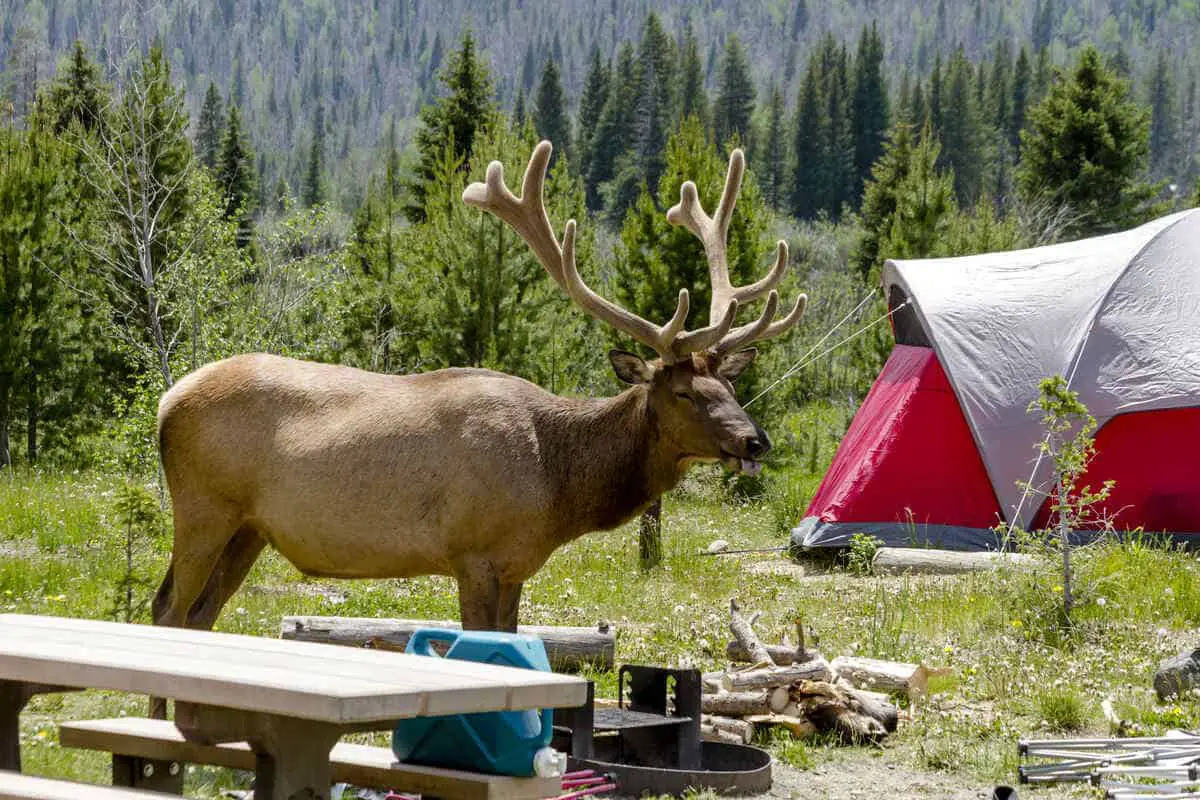Heading to a campground in Banff National Park? Get ready to share your site with an incredible diversity of wild creatures! In this article, you’ll read about the different mammals, birds, reptiles, and amphibians you might encounter during your camping trip in Banff. You’ll also read how you can safely and respectfully share the wilderness with these critters.
Camping in Banff National Park means, by definition, sharing your campsite with animals, as wildlife is abundant in the park. It’s exciting and interesting. It can make for great pictures and some unexpected interludes.
Since you’re probably not used to dealing with wildlife and small critters around your bed, it’s good to know what to expect and look out for. That’s why I wrote this article.
If you want to know more, I invite you to read on!
Mammals of Banff National Park Campgrounds
While there are many species of animals in Banff National Park, the mammals are likely to impress you the most and are the most dangerous. I have summarised below the two most commonly seen on or near campsites.
Bears
Of all the mammals in Banff, bears require the most caution and respect from campers. Both black bears and their larger grizzly cousins frequently wander through campgrounds, checking trash bins and unlocked food storage for an easy meal.
Keep food in bear-proof containers inside your vehicle and thoroughly clean up crumbs. Most campgrounds in the park have on-site bear-proof storage lockers.
Also, don’t keep scented items like toothpaste or sunscreen in your tent, as the smells attract curious bears. Make plenty of noise when hiking on trails to avoid surprising a bear around the bend.
While confrontations are rare, give bears plenty of space and never startle or approach them.
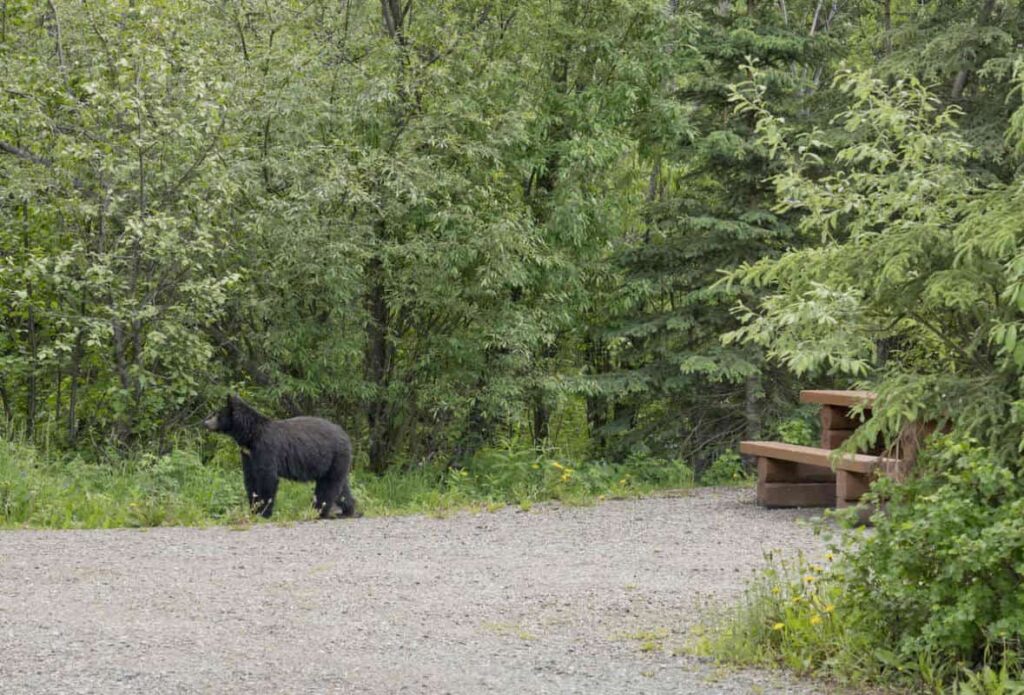
It’s good to know that black bears and grizzlies look different and behave differently. How to distinguish them?
Black bears typically have a brown snout, a straight facial compared to grizzlies, and dark brown or black fur. Grizzlies have a brown coat and distinctive shoulder hump.
Grizzlies are the most common bear in Banff National Park and are apex predators. You should always give deference.
Both bears may bluff charge if startled, so slowly back away, never turning your back. Keep bear spray handy and use it safely as a last line of defense.
Report any aggressive bear activity to rangers immediately.
If you’re so unlucky that a bear charges you, there are different ways to respond.
First, use bear spray when the bear is within close range, say 6 to 10 meters (20-30 ft). If that doesn’t work, or you weren’t smart enough to bring bear spray, you need to know what kind of bear is attacking you and how to respond to this species.
ALSO READ: How to use bear spray
If confronted by a black bear, fight back (no kidding). It might chase the bear away. Don’t climb a tree to save yourself. Black bears have strong curved claws that allow them to climb trees.
If it’s a grizzly, lie still on the ground with your hands around your neck and your arms protecting your face.
Elk
Elk also commonly meander through Banff’s campgrounds. Bull elk can become quite aggressive in the fall rutting season as they round up harems of females, so give them a very wide berth. Cow elk may be protective of their calves in spring and early summer.
Never approach or photograph elk calves, as the mothers are highly defensive. Simply admire Banff’s regal elk from a safe distance and let them pass through campgrounds undisturbed.
Listen for the eerie high-pitched bull elk bugling in the fall as the rutting season begins. This call attracts females to the bull’s harem.
Elk migrate to lower elevations around Banff in winter, browsing shrubs and grasses crusty with snow. Listen for them bellowing around dawn and dusk. Cows with calves can be defensive in spring, so keep your distance.
Little Critters
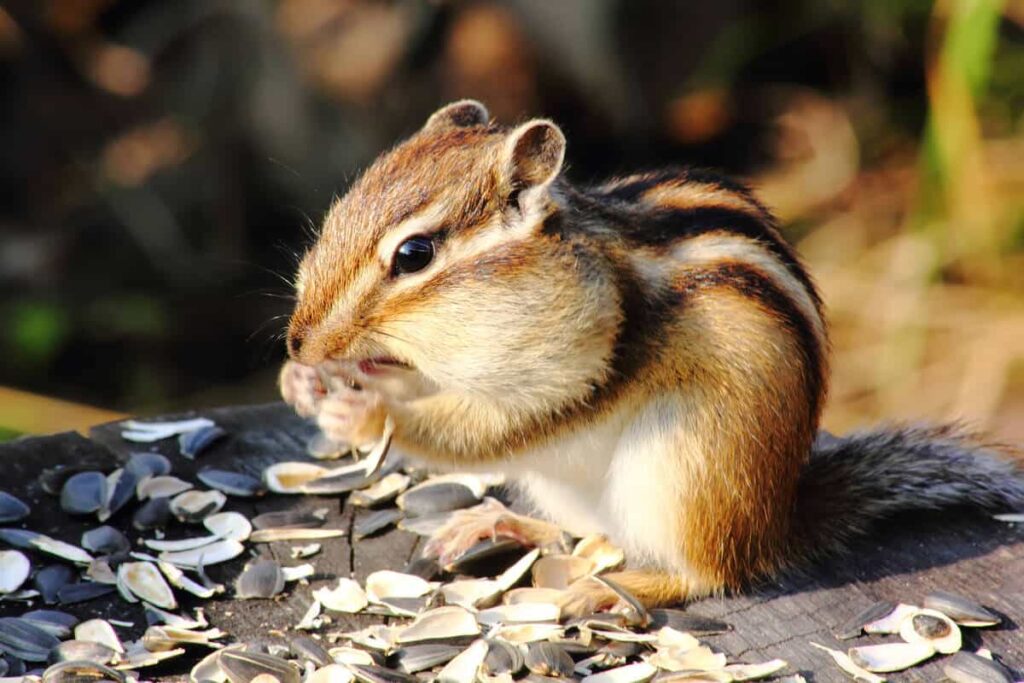
Little critters like ground squirrels, chipmunks, red squirrels, and least chipmunks will probably delight you with their antics but can also be a nuisance around camp kitchens and picnic sites.
With lightning-fast speed, they will try to pilfer any unattended food or crumbs left out. Keep all food items securely locked away, including items stored inside tents where curious paws can rip through the fabric.
Check under vehicle hoods before driving off, as rodents like to climb into warm engines. Resist the urge to hand feed or interact with these tame but wild animals, no matter how cute they appear.
Skunks are another small mammal drawn to campgrounds by the promise of food scraps. With their distinctive white stripes down the back and fluffy tails, skunks are generally docile creatures.
However, they will spray their pungent defensive odor when threatened or startled. Give skunks plenty of space, especially around dens with babies. Never startle or threaten a skunk unless you want your tent and clothing to reek!
Other mesocarnivores, like pine martens, cougars, coyotes, and lynx, are rarely seen in campgrounds but may pass through the outer edges of campsites. Look for tracks and scat from these elusive forest dwellers.
You might also glimpse a mule deer doe wandering near meadows and forest fringes. Keep dogs leashed and supervised, as coyotes view unattended pets as prey.
Birds of Banff Campgrounds
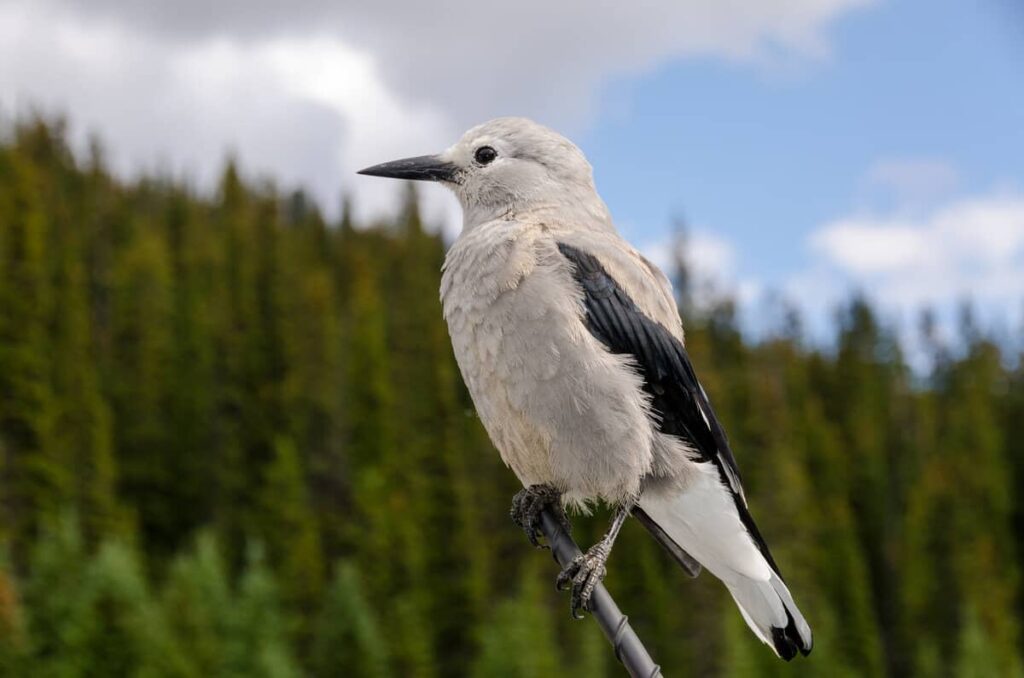
In addition to fascinating mammals, many birds frequent Banff’s campgrounds. Clever Clark’s nutcrackers and common ravens make their presence known as they scout for unattended food at picnic sites.
Listen for the raucous squawks and croaks of these intrepid birds. While their antics are entertaining, do not encourage them by leaving food unattended or trying to hand-feed them.
Listen for the gentle hoots and drumming wings of spruce grouse displayed in the forest at dawn and dusk. Males perform their hooting song and strutting dances when trying to attract a mate in spring. Look but don’t approach their ground nests.
In addition to jays, campgrounds host mountain chickadees, brown creepers, red-breasted nuthatches and other songbirds that forage in flocks.
Watch for the flashes of yellow and red feathers. Woodpeckers like the northern flicker with its polka-dot plumage probe for beetles hiding in the bark. Owls such as the tiny saw-whet and formidable great gray hunt at night.
Around lakes and rivers, watch for bald eagles perched in trees or soaring in wide circles over the water in search of fish. Osprey may also make a splash diving for trout.
Shorebirds like spotted sandpipers scurry along the water’s edge probing for insects. Over open meadows, you might see red-tailed hawks rise on thermals scanning for their next meal.
Yup, Banff campgrounds host a fascinating diversity of bird life!
ALSO READ: Birdwatching in Banff National Park
Reptiles and Amphibians of Banff Campgrounds
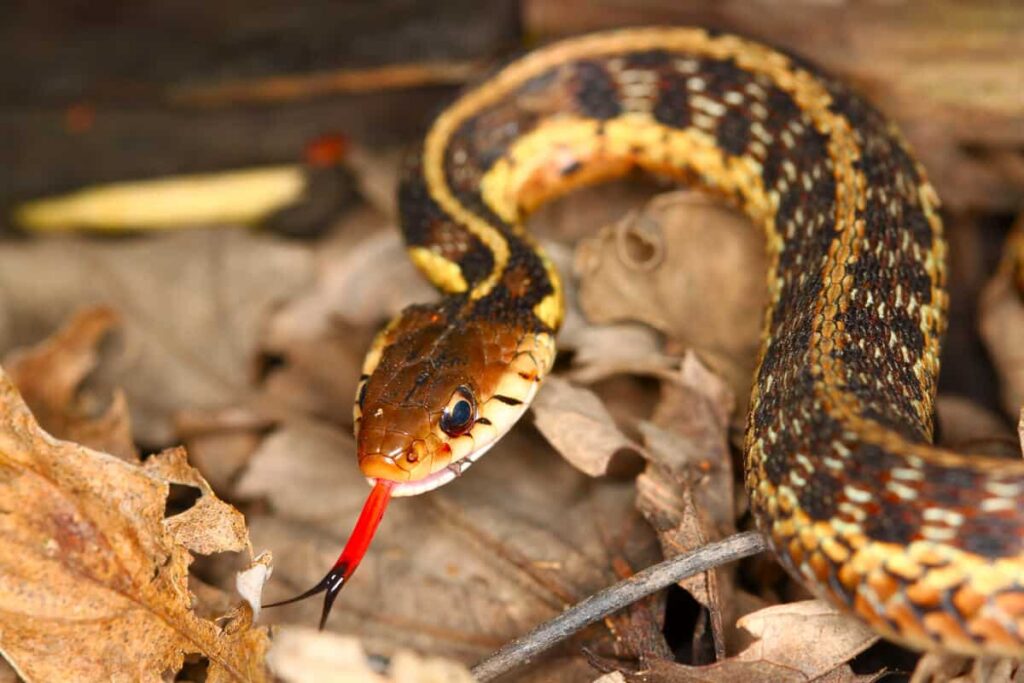
Though often overlooked, Banff National Park is home to various reptiles and amphibians beyond just birds and mammals.
Several Banff snake species slither through the campground underbrush as they help control rodent and insect populations. These snakes include the wandered garter snake with its brightly colored yellow, red and black stripes.
The plain garter snake has lighter brown and tan stripes down its back and a small head. Listen for garter snakes slithering through dry leaves and grass.
The western terrestrial garter snake is a highly aquatic species found near water bodies like ponds and streams in campgrounds. Keep an eye out for their blue spots between the stripes.
Racers, rubber boas, and the bull snake may also be seen around campground peripheries hunting for mice and voles. Watch where you step and avoid disturbing snakes when possible.
Observe tails, tracks, scat, and molted skins to discover signs of them. However, you won’t easily find these signs as they’re reclusive reptiles (which is not a bad thing for most people, I imagine).
While the possible presence of snakes at Banff campgrounds may sound scary, garter snakes are harmless to humans.
Also, listen to the chorus of frogs and western toads (species at risk in Banff National Park) trilling from lakes and ponds on warm nights. Their mating calls signal spring in Banff’s aquatic habitats. Don’t handle toads and frogs, as their skin can secrete irritants.
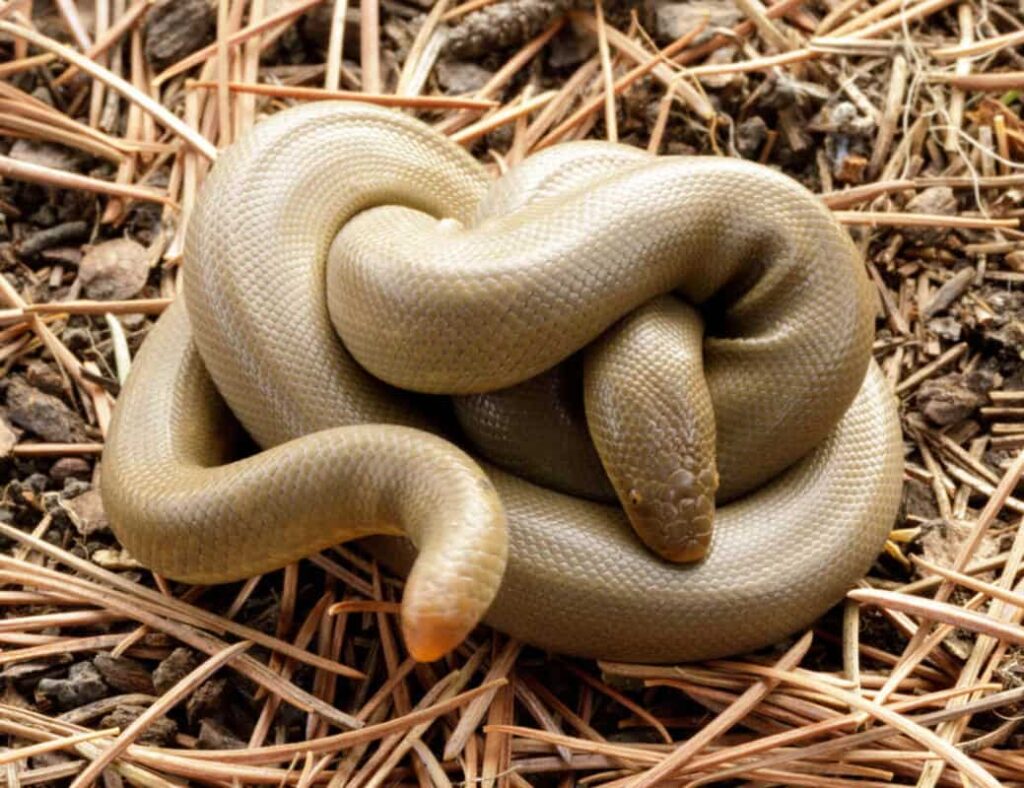
Safety Tips for Banff Campgrounds
When sharing campgrounds with large wild mammals like bears and elk, exercise caution and follow safety guidelines. If you stick to the ones I listed below, you should be fine.
- Keep food securely stored away from tents in animal-proof containers or park storage lockers. Never keep food or scented items in tents or sleeping areas.
- Cook and eat away from sleeping areas and store all leftovers immediately after meals. Scrape grill grates clean.
- Set up campsites away from dense bushes where wildlife may hide and 100 meters from backcountry trails. Avoid camping near evidence of animal feeding or carcasses.
- Keep a clean camp to avoid attracting curious animals. Dispose of trash promptly in bear-proof bins. Take trash to dumpsters frequently.
- Make noise when hiking to prevent surprising animals around blind corners. Hike in tight groups. Be alert to your surroundings.
- Avoid hiking at dawn, dusk or night when wildlife is most active. Exercise caution and make noise near streams and thickets.
- Keep dogs leashed (mandatory in the park!) and away from wildlife. Unattended dogs may be seen as prey by large mammals.
- Know proper bear safety (see above). Identify yourself so bears recognize you are not prey. Back away slowly without turning away.
- Carry bear spray readily accessible, and know how to aim/use it. You can also use bear bangers to frighten aggressive animals.
- Follow park rules and advisories regarding trail/area closures due to wildlife activity. Don’t hike in restricted areas.
- Notify park officials immediately about dangerous wildlife behavior. Don’t approach injured animals – observe from afar.
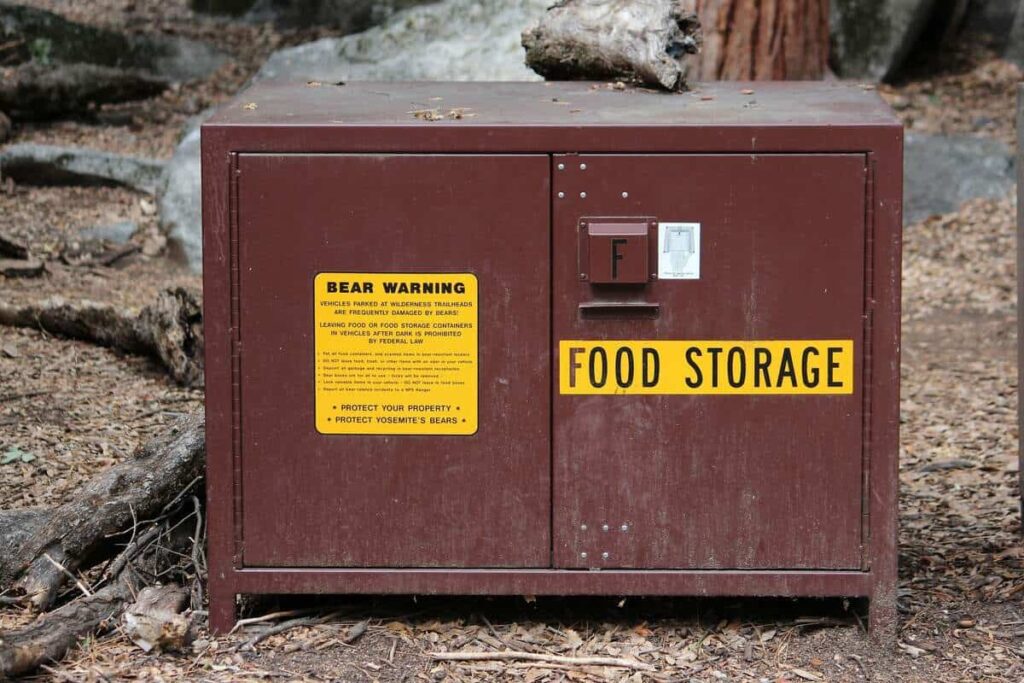
Camping Etiquette to Keep Banff Critters Wild
By following common-sense camping guidelines, we can all safely and enjoyably share the wilderness with Banff’s wildlife:
- Keep campsite grills and picnic tables free of food and wipe up all crumbs. Bears and birds can smell even tiny morsels.
- Dispose of trash immediately in designated bear-proof bins. Take garbage to dumpsters promptly.
- Report messy campsites that might attract wildlife to park staff.
- Never feed wild animals or encourage begging behavior. Feeding leads to dependence, unnatural behavior, and loss of the animal’s ability to forage naturally.
- Follow all park signage and overnight backcountry camping regulations.
Read up on proper bear safety precautions before your trip. You also might want to talk to park staff for the latest guidance. Remember that wildlife faces threats and challenges daily.
Minimizing negative human impacts through low-impact camping can help preserve Banff’s ecosystems.
Follow Leave No Trace principles (“Plan Ahead and Prepare. Travel & Camp on Durable Surfaces. Dispose of Waste Properly. Leave What You Find”) by staying on designated trails, packing out all trash, burying human waste properly, and leaving campsites pristine.

